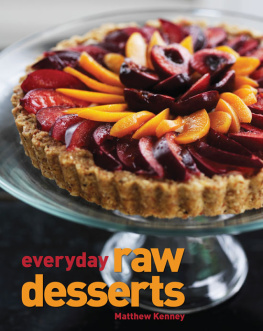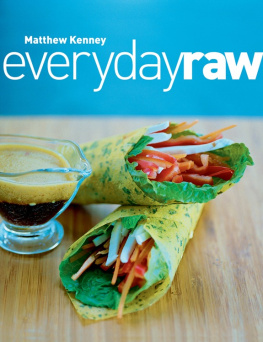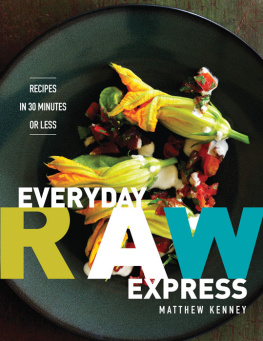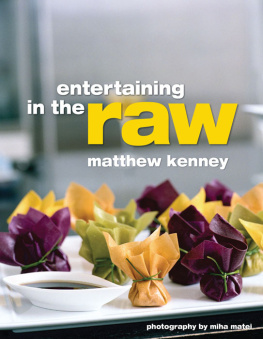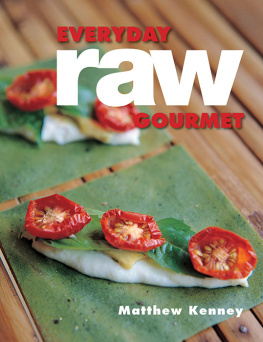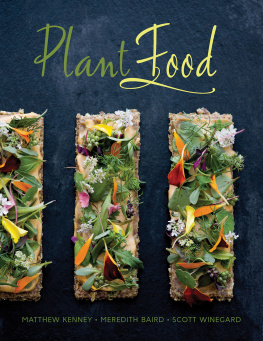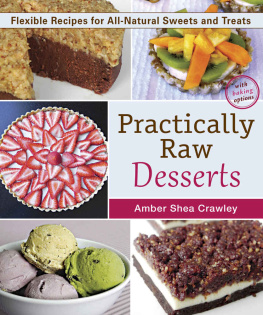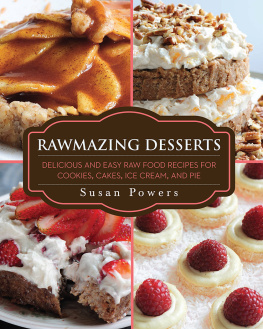All rights reserved. No part of this book may be reproduced by any means whatsoever without written permission from the publisher, except brief portions quoted for purpose of review.
Acknowledgments
In the romantic sense, the term chef implies an individual, mastering a kitchen and whipping up magical recipes to an adoring public. In reality, the art of cooking on a professional level is also about team building and developing working relationships with like-minded, talented individuals who will add to, or even enhance, the end result of your efforts.
Since my very first days working with food, I have had the good fortune to collaborate with many unique people, all of whom have contributed to, supplemented, or guided my direction. That is especially true of cookbooks I have authored.
During the entirety of the development of Everyday Raw Desserts, Meredith Baird has been carrying out the vision for this book, carefully crafting, testing, researching, and otherwise bringing to life the many unique recipes and processes that it includes.
My gratitude goes out to her, not only for this commitment, but also for the gift of the talent she offered to the process. Without Meredith, you would not be so close to enjoying a number of amazing raw desserts. Her imprint is on every recipe and page of this book.
I also thank Adrian Mueller, a wonderful photographer and human being, for his patience, dedication, and ability to work through a week of driving rain on the Maine coastour next shoot will have sun!
Jessica Acs, who flew to Maine from Canada to join our photo shoot, provided the perfect balance of peace and added energy needed to produce 50 raw dishes in just a few days. Your cupcakes rocked!
The production of a cookbook is a finely tuned process, much like theatre. Many components provide challenges and the navigation, coordination, and decision making of putting a book together all require extraordinary talent. Many thanks to my talented editor, Jennifer Adams, who has guided two of my previous books, Everyday Raw and Entertaining in the Raw, and now Everyday Raw Desserts.
Also, to Gibbs Smith and the entire team at Gibbs Smith for their ongoing commitment to creating beautiful and meaningful books.
Finally, I would like to thank all of my business partners, Roman Schatzby, Dara Prentice, Raymond Azzi, and many others who believe in, and support, the ongoing commitment we all share toward enhancing the world of sustainable cuisine.
Introduction
Everyone familiar with the raw food world knows the poorly kept secret of how rich, decadent, and colorful its desserts can be. In fact, aside from its many well-documented health benefits, desserts may be raw foods biggest asset. In my own transition to a vegan lifestyle, it certainly made the path much more appealing once I learned that I would still be surrounded by more pies, tarts, cookies, cakes, and chocolate than one could ever imagine. The presence of desserts has been prominent since my initiation, although it has only been recently that I have grown to understand the incredible potential of these sweet creations.
When I first started working with living cuisine, before even owning a Vita-Mix or having opened a young coconut, raw desserts were pretty straightforward, slightly heavy and often including some non-raw ingredients. Agave nectar wasnt as popular as it is today, and raw cacao powder was just becoming readily available, so we still used cocoa powder or carob for chocolate recipes, and refined, original techniques to use as reference were few and far between. A few years of working with the plant-based cuisine, and affiliations with several talented chefs have elevated the results of the cuisine I am involved with. No aspect better represents this creative growth than desserts.
It wasnt until I discovered raw food that I found I could thoroughly appreciate desserts, at least in the way that I do now. Refined sugar, flour, and dairy products render desserts not only bland (to a palate accustomed to pure, clean flavor) but also unhealthy and certainly not providing the guiltless pleasure found in raw desserts. Just as I did in my prequel to this book, Everyday Raw, I am fully understanding of the challenges we face to prepare delicious raw food at home, with a limited amount of kitchen time available. The recipes in this book recognize the need for streamlining and are designed for efficiency. Although many still involve several steps, which elevated raw food always does, they are organized in such a way that most can be quickly assembled and easily stored.
These new recipes also take into account the way we like to eat at home on a regular day, usually in a casual manner, without a lot of fuss and service requirements. The majority of these dishes can be made well ahead of time, and, once prepared, can be served in a matter of seconds. The one bit of advice I always offer is that, as a home cook, you should always view a recipe as a guide, rely on it as much as necessary, but also feel free to use your own intuition if you prefer something a little more or less sweet, richer, softer, or otherwise different than what the book recommends. Ingredients are not always identical, climates change our tastes, and every palate is different than the other, so try to be flexible and enjoy the process, especially when you get to eat.
My Dessert Philosophy
There are many characteristics that inspire me when considering what I love about raw desserts, but one stands out more than the others: seasonality. Seasons are my guiding force for all cuisine, whether it is desserts or savory dishes. I believe in food that looks as good as it tastes, and vice versa. Presentation is not everything but it counts for a lot, especially when preparing meals for others. Although I do enjoy an abstract dessert on a special occasion, I tend to like comfortable recipes, with a modest number of ingredients and components. Ultimately, the same words that have influenced my work for years, clean and sexy, along with light, when possible, continue to guide what I really like.
High quality, seasonal, organic ingredients at their freshest are the building block of any great cuisine. We spend nearly as much energy searching for great products as we do preparing them. Although a dish that may have been prepared with a few minor errors can still taste great if the ingredients are all superior, no amount of culinary skill can ever mask inferior, under-ripe, or poor quality products. For that reason, I believe in building a network of suppliers to source your favorite ingredients. We are fortunate to live in areas where we have access to all the best ingredients. Although we do use a number of regional or seasonal products here, we have tried to provide options for them that will allow you to make substitutions as needed. Other ingredients may not be locally available, but everything in this book is easily accessible online if not locally.
More than ever before, I believe in respecting geographical recipes and classic flavor combinations. Nothing about raw food is classic, but we do make an effort to present food that, although in an entirely new form, still tastes familiar and is pleasant, never shocking. Raw food is new to many, and in the end, it is part of a meal to be enjoyed, rather than experimented with. There is nothing better than seasonal fruits, so we have worked to keep summer and fall recipes including them as simple as possible, allowing the fruit to be served in its natural state; heavier winter dishes often include more elaborate and bold flavor components.

